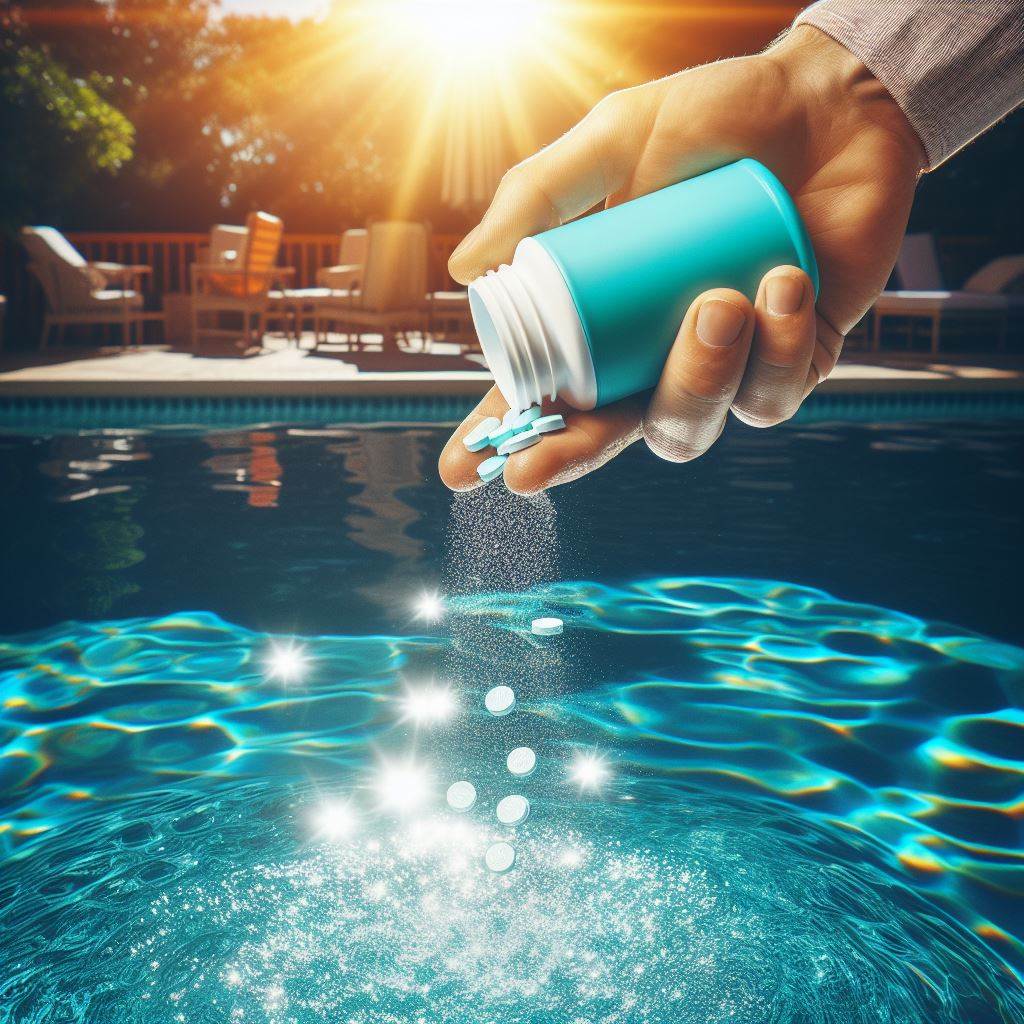In maintaining a family swimming pool, using chemical agents correctly is key to ensuring water cleanliness and safety. Algaecides, flocculants, and chlorine tablets are three common pool chemicals, each serving different functions. The correct order and timing of their application can maximize their effects and maintain the pool’s healthy state. This article will detail the correct methods of using these chemicals, along with their functions and optimal deployment strategies.

Using Algaecides
Function and Importance
Algaecides are primarily used to eliminate and prevent the growth of algae in the water. Algae can not only turn pool water green but can also become a breeding ground for bacteria and other microorganisms, affecting the pool’s aesthetics and water safety.
Timing and Method of Application
Algaecides should be used immediately when algae first appear or as part of regular maintenance once a month. They are usually applied at the initial stage of pool cleaning to ensure the water quality is good from the start. The required dosage should be calculated based on the volume of pool water and the severity of the algae, then evenly dispersed over the pool surface, preferably while the pump is operating to help distribute the chemical more evenly.
Adding Flocculants
Function and Effect
Flocculants work by causing small particles in the water to clump together into larger aggregates, making them easier to be captured and removed by the filtration system, effectively clearing suspended particles in the water.
Timing and Method of Application
At least 24 hours after treating with algaecides, once algae and other impurities have died and begun to decompose, add flocculants. The addition of flocculants needs to be done while the filtration system is running to ensure widespread distribution throughout the pool. Typically, the required amount of flocculant should be adjusted based on the size of the pool and the current water quality.
Adding Chlorine Tablets
Function and Necessity
Chlorine tablets are used to disinfect and keep the pool water clean, effectively killing bacteria, viruses, and other microorganisms, preventing water quality degradation.
Timing and Method of Application
Wait at least 2-3 hours after adding flocculants to allow the flocculant to fully take effect before adding chlorine tablets. This interval prevents interference between chemical reactions and ensures that each chemical can work effectively. Chlorine tablets are typically placed in a floating dispenser in the pool to dissolve slowly, continuously releasing chlorine and maintaining ongoing water disinfection.
Regular Water Quality Testing
Importance
Regular testing of the pool water’s pH, chlorine levels, and other relevant chemical indicators is very necessary. This helps determine if the dosage or strategy of chemical treatments needs adjustment.
Testing Method
Use a pool testing kit to regularly test water quality and adjust the use of chemicals based on the results. If tests show an imbalance in pH or chlorine levels, it may be necessary to add pH adjusters or additional chlorine.
Overall Pool Maintenance
Importance of Comprehensive Maintenance
In addition to chemical treatment, overall maintenance of the pool also includes regular cleaning, checking the filtration system, and pump equipment. These are key to keeping the pool in optimal operating condition.
Maintenance Measures
Ensure that the pool’s filtration system is regularly cleaned and maintained, with filters cleaned or replaced as per the manufacturer’s instructions. The condition of pumps and other circulation equipment should also be regularly checked to ensure they are effectively circulating and filtering the pool water.
Seasonal Adjustments
Considering Seasonal Changes
Depending on seasonal changes, the needs for chemical treatment of the pool may vary. For example, more frequent additions of chlorine tablets may be necessary in summer due to higher temperatures and increased pool usage, which accelerates chlorine consumption.
Adjustment Strategy
In summer, increase the frequency and quantity of chemical additions to ensure the water quality remains in an ideal state. In winter, if the pool is not in use, reduce the use of chemicals but still maintain basic water quality management to prevent the breeding of algae and bacteria.
Safe Use of Chemicals
Safety Measure
Always wear appropriate protective gear, such as gloves and goggles, when handling any chemicals. Ensure chemicals are stored out of reach of children and pets.
Proper Storage
Chemicals should be stored in a dry, cool place and away from direct sunlight. Ensure containers are well-sealed to prevent leaks and cross-contamination of chemicals.
Summary
The correct sequence and timing of chemical deployment are crucial for the chemical maintenance of a family swimming pool. Start with algaecides to clear algae, wait at least 24 hours before adding flocculants to remove fine impurities, and then wait a few hours before adding chlorine tablets for disinfection. Such order and time management ensure that each chemical can maximize its effectiveness without interference from others. Proper maintenance not only keeps the pool water clean but also ensures the safety and comfort of its use. Comprehensive management of the family pool involves not only the correct use of chemicals but also regular physical cleaning and equipment maintenance. By following the correct chemical deployment sequence and intervals, regularly testing water quality, and performing comprehensive pool maintenance, the water quality of the pool can always be maintained in the best condition, providing a safe, clean swimming environment for the family.


